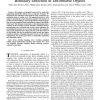Free Online Productivity Tools
i2Speak
i2Symbol
i2OCR
iTex2Img
iWeb2Print
iWeb2Shot
i2Type
iPdf2Split
iPdf2Merge
i2Bopomofo
i2Arabic
i2Style
i2Image
i2PDF
iLatex2Rtf
Sci2ools
TIP
2008
2008
Learning the Dynamics and Time-Recursive Boundary Detection of Deformable Objects
We propose a principled framework for recursively segmenting deformable objects across a sequence of frames. We demonstrate the usefulness of this method on left ventricular segmentation across a cardiac cycle. The approach involves a technique for learning the system dynamics together with methods of particle-based smoothing as well as nonparametric belief propagation on a loopy graphical model capturing the temporal periodicity of the heart. The dynamic system state is a low-dimensional representation of the boundary, and the boundary estimation involves incorporating curve evolution into recursive state estimation. By formulating the problem as one of state estimation, the segmentation at each particular time is based not only on the data observed at that instant, but also on predictions based on past and future boundary estimates. Although this paper focuses on left ventricle segmentation, the method generalizes to temporally segmenting any deformable object.
Related Content
| Added | 15 Dec 2010 |
| Updated | 15 Dec 2010 |
| Type | Journal |
| Year | 2008 |
| Where | TIP |
| Authors | Walter Sun, Müjdat Çetin, Raymond C. Chan, Alan S. Willsky |
Comments (0)

